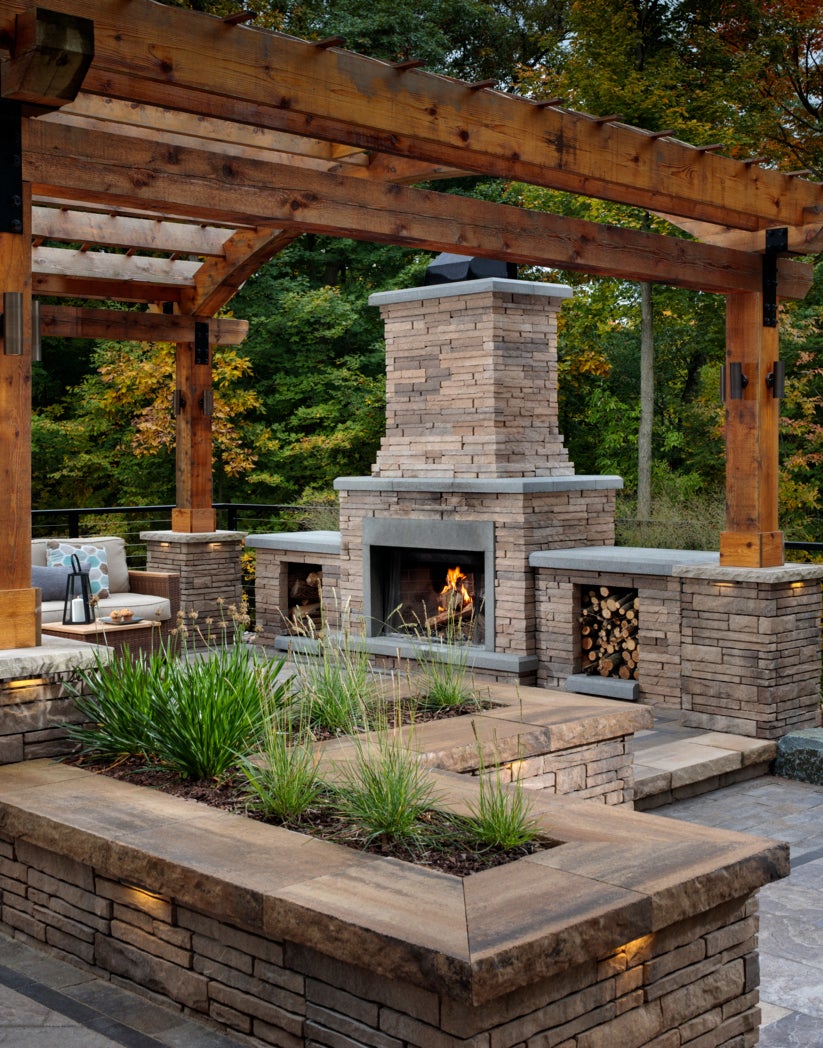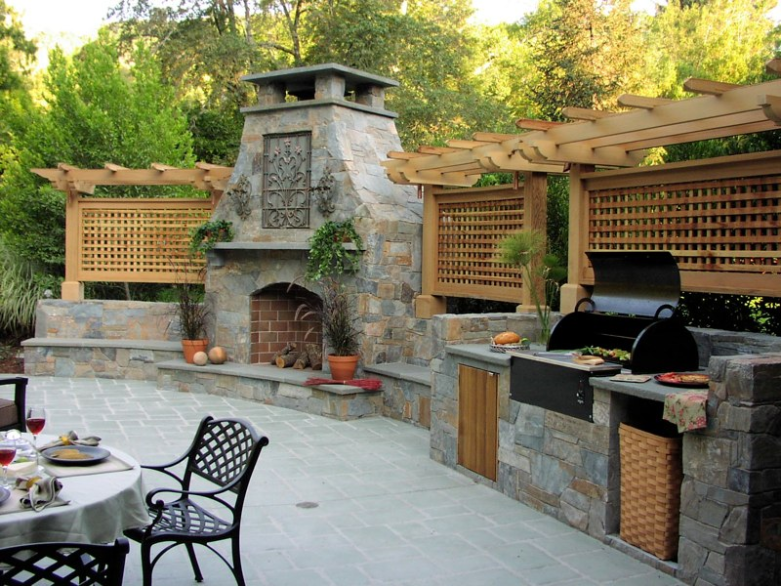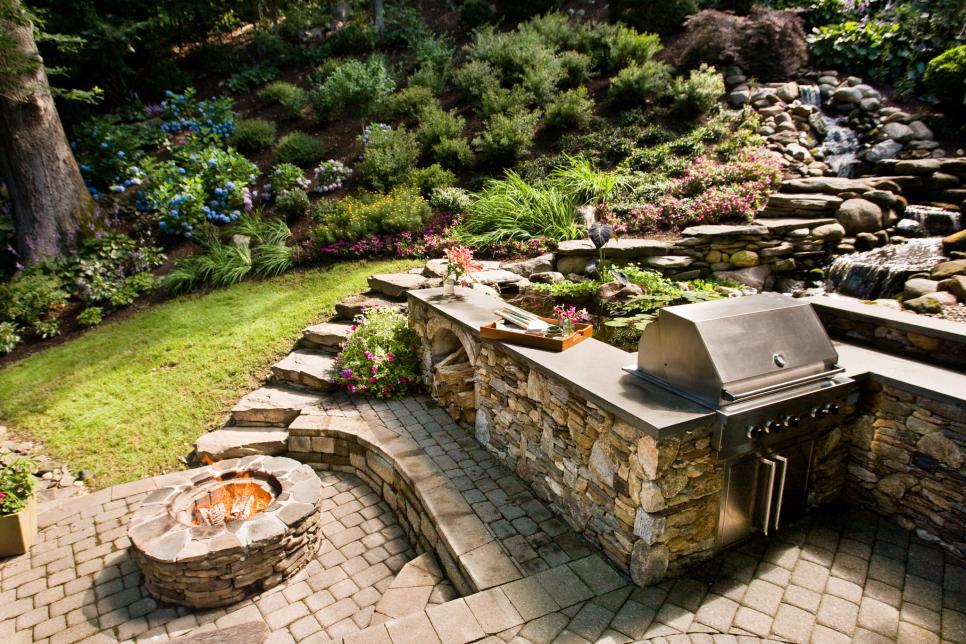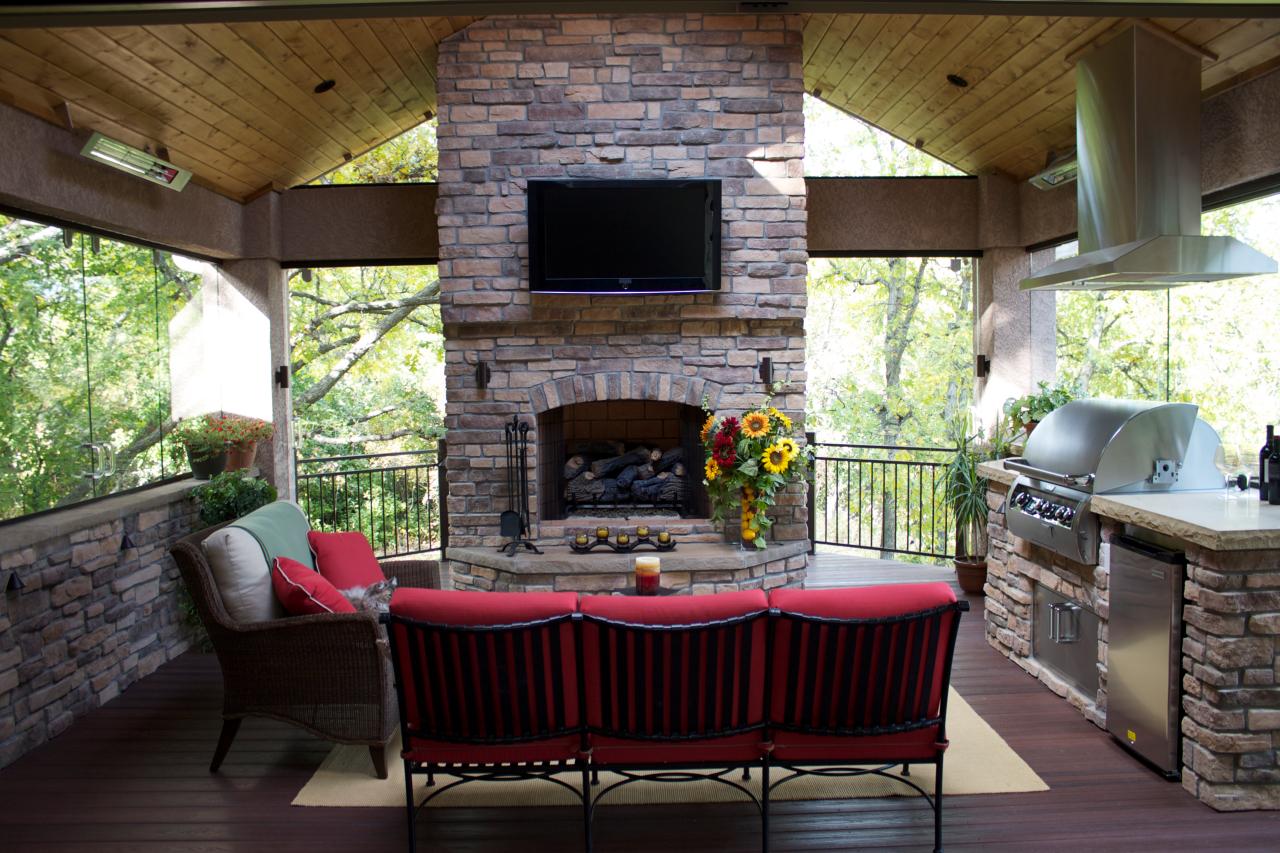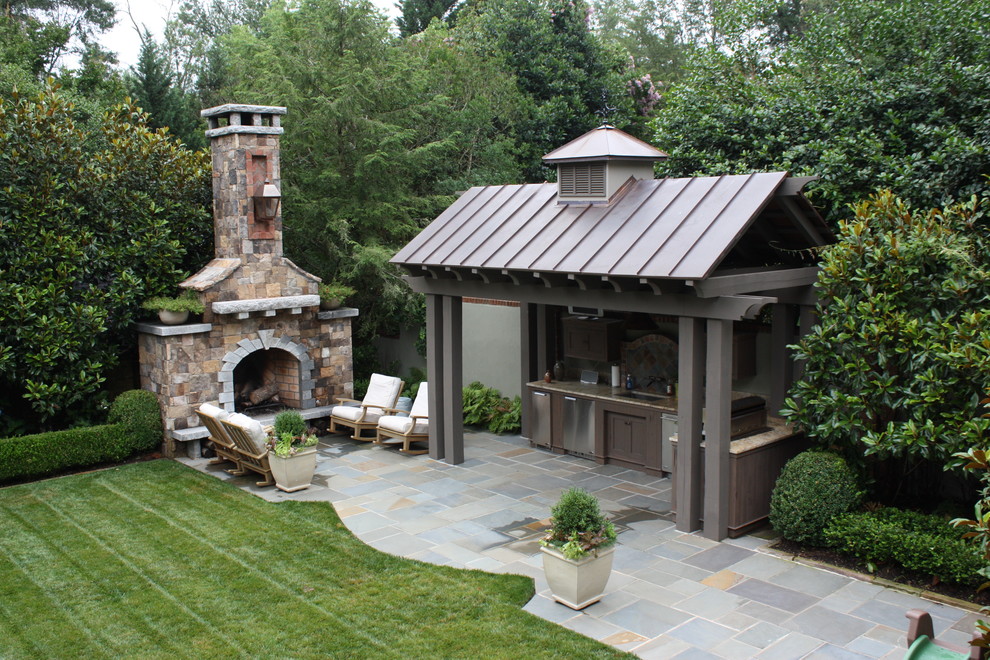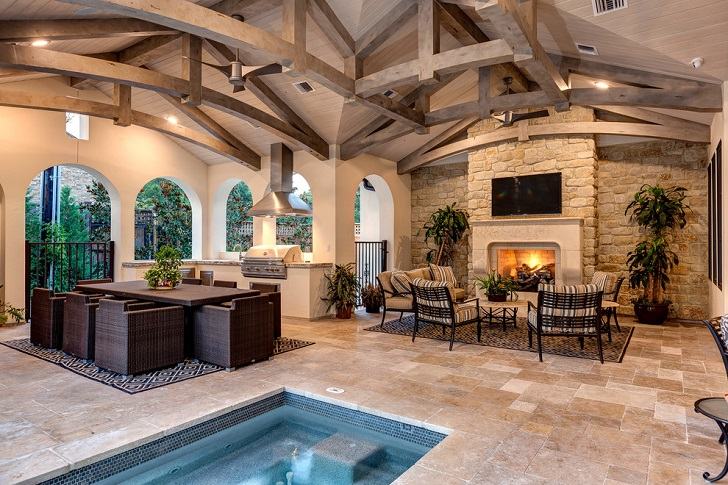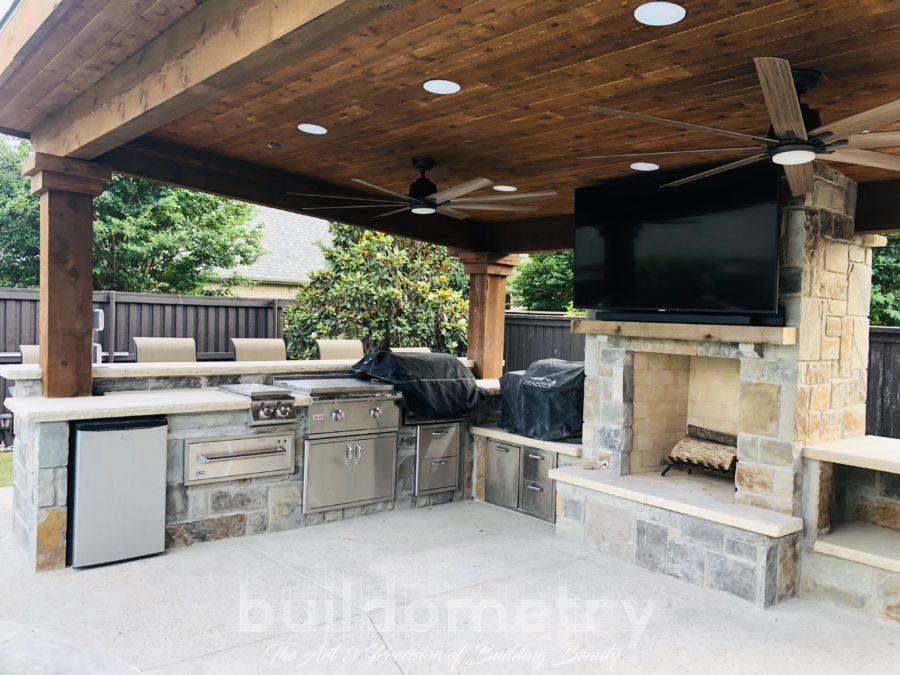Outdoor fireplace kitchens blend the warmth of a hearth with the functionality of a cooking space, transforming backyards into year-round entertainment destinations. These multifaceted structures combine stone or masonry fireplaces with built-in grills, countertops, and storage to create seamless outdoor living areas. Unlike standalone barbecues, fireplace kitchens become permanent focal points that elevate property value while providing practical cooking solutions. Designs range from rustic wood-burning setups with pizza ovens to sleek gas-fired modern installations with integrated refrigeration. The fireplace component extends usability into cooler months, radiating heat that makes outdoor gatherings comfortable even on chilly evenings. Whether incorporated into a poolside cabana or as the centerpiece of a patio, these hybrid spaces encourage social cooking and relaxed dining in fresh air.
Key Design Elements for Functionality
A well-planned outdoor fireplace kitchen begins with strategic layout of cooking zones. The fireplace typically anchors one end, with adjacent counter space for food prep and serving. Built-in grills or wood-fired ovens should be positioned downwind from seating areas to minimize smoke interference. Durable countertop materials like granite, concrete, or tile withstand weather while providing ample workspace. Storage cabinets designed for outdoor use keep cooking tools and dinnerware protected yet accessible.
Ventilation requirements differ based on fuel type—wood-burning designs need proper chimney drafting, while gas models require different airflow considerations. The cooking surface height should match indoor kitchen standards for comfortable use, typically 36 inches. Incorporating a sink with hot and cold water simplifies cleanup, though requires professional plumbing. Overhead structures like pergolas or roofs protect the cooking area from rain while allowing smoke to dissipate.
Lighting plays a crucial role in nighttime functionality. Task lighting over prep areas, ambient lighting for the fireplace glow, and pathway lighting for safety create a layered scheme. Electrical outlets should be weatherproof and conveniently placed for small appliances. The overall design should facilitate a natural workflow from preparation to cooking to serving, just like an indoor kitchen.
Material Selection for Durability
Fire-resistant materials form the foundation of any outdoor fireplace kitchen. Firebrick lines the interior of wood-burning units, while refractory concrete suits gas fireplaces. Exterior cladding options include natural stone, brick, stucco, or tile—all chosen for weather resistance and aesthetic appeal. Stainless steel components resist corrosion in grill inserts, doors, and hardware.
Countertop materials must endure temperature fluctuations and UV exposure. Quartzite and granite offer heat resistance for areas near the fire. Poured concrete can be formed with integral drain boards and tool grooves. Tile surfaces allow creative patterns but require sturdy substrate and quality grout. Avoid porous stones that may stain from food or grease splatters.
Structural elements demand careful material pairing. Steel lintels support masonry over openings, while concrete footings prevent settling. Waterproof membranes behind stone veneer prevent moisture damage. All fasteners and anchors should be stainless steel or galvanized. The material palette should complement the home’s exterior while standing up to local climate conditions.

Fuel Type Options and Considerations
Wood-burning fireplace kitchens deliver authentic flavor and ambiance but require more maintenance. Traditional designs accommodate both cooking and heating needs, with adjustable grates for temperature control. Pizza ovens and smoke boxes can be incorporated for specialized cooking. The downside includes ash cleanup, wood storage needs, and potential burn restrictions in some areas.
Gas-powered options offer convenience with instant ignition and precise heat control. Propane or natural gas lines fuel both the fireplace and grill components. Many models feature adjustable flame settings for cooking versatility. While lacking wood’s smoky flavor, gas systems provide cleaner operation and easier temperature regulation. Some homeowners add smoker boxes or charcoal inserts for occasional wood-fired taste.
Hybrid systems combine the best of both worlds—gas ignition for easy starts with wood chips for flavoring. Electric options suit areas with strict emissions regulations but lack the visual impact of real flames. The choice depends on local fuel availability, cooking preferences, and desired maintenance levels. Professional installation ensures safe fuel line connections regardless of type.
Seating and Entertainment Integration
Thoughtful seating arrangements maximize the fireplace kitchen’s social potential. Built-in stone or concrete benches with removable cushions provide permanent yet comfortable lounging. Bar-height counters with stools create casual dining spaces near the cooking action. The fireplace should be positioned to radiate heat toward seating without smoke interference.
Entertainment features elevate the experience. Outdoor-rated televisions can be mounted under protective eaves. Sound systems with weatherproof speakers set the mood without cluttering space. Some designs incorporate firewood storage as decorative elements near seating. Cooling features like ceiling fans or misting systems balance the fireplace’s warmth in summer.
Traffic flow deserves careful planning—allow at least 36-inch pathways between all functional areas. The space between seating and cooking zones should permit easy serving while preventing accidental burns. Multi-level designs create visual interest and natural separation between conversation and cooking areas.
Shelter and Weather Protection
Permanent overhead structures extend the fireplace kitchen’s usability. Solid roofs with proper drainage protect from rain but require ventilation for smoke. Pergolas offer partial shade while allowing heat to rise from the fireplace. Retractable awnings provide flexible coverage that can be adjusted as needed.
Windbreaks like glass panels or lattice screens shield cooking flames from breezes without blocking warmth. Corner installations take advantage of existing walls for natural protection. In snowy climates, sloped roofs prevent heavy accumulation. All overhead elements must meet clearance requirements for fireplace safety.
Flooring materials should be non-slip and heat-resistant near the fireplace. Flagstone, textured concrete, or porcelain tile handle high traffic while complementing the design. Proper grading and drainage prevent water pooling in cooking and seating areas. Strategic landscaping can enhance wind protection and privacy.
Lighting and Ambiance Creation
Layered lighting transforms the space from daytime kitchen to nighttime retreat. LED strip lighting under counters provides subtle task illumination. Wall sconces or pendant lights over dining areas establish inviting pools of light. The fireplace itself becomes a natural light source that flickers across stone surfaces.
Dimmable controls allow adjustment from bright cooking light to soft evening ambiance. Pathway lighting ensures safe navigation after dark. Spotlights can highlight architectural details or landscaping features. Solar-powered accent lights add decorative touches without wiring.
Special effects like fireglass in gas fireplaces or LED-lit water features enhance the atmosphere. The lighting plan should minimize glare that could interfere with the fire’s visual appeal. Smart lighting systems enable remote control and scheduling for effortless entertaining. Proper lighting extends usable hours while showcasing the fireplace kitchen’s best features.
Best Outdoor Kitchen Ideas and Designs – Pictures of Beautiful
Fire Pits and Fireplaces in Outdoor Kitchens
Gorgeous Backyard Kitchen Designs DIY Network Blog: Made +
OUTDOOR KITCHENS – DesignScapes Of Long Island
Big Green Egg Outdoor Kitchen Ideas
Outdoor kitchen and Fireplace – Traditional – Patio – Other – by
Unique outdoor kitchen designs u2013tips and ideas for your summer kitchen
Ask Yourself These 3 Questions to Design Your Perfect Outdoor Kitchen
Related Posts:
- Stacked Stone Outdoor Fireplace
- DIY Small Outdoor Fireplace
- Outdoor Fireplaces Firepits
- Simple Brick Outdoor Fireplace
- Ideas For Outdoor Fireplaces On Patios
- Outdoor Fireplace Ideas Stone
- Outdoor Rock Fireplace Designs
- DIY Outdoor Fireplace Designs
- Outdoor Fireplace Ideas Deck
- Outdoor Cooking Fireplace Designs



